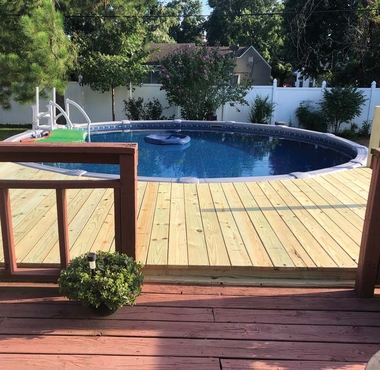Always read the fine print

by Bruce Hartley
Life Columnist
This past summer was my first summer living in Oklahoma and not living in Missouri. I realized quickly that the temperatures, humidity, and heat indexes played a role in high utility bills and my comfort.
My fiancé Bill and I decided the best way to tackle the hot Oklahoma summer was to invest in a semi-inground swimming pool. Bill and I have been tackling home renovations since Memorial Day, and this was our most recent project.
We saw advertisements for a local pool company conveniently placed at a time when we were especially tired of the heat. We did some research online and headed to the pool store. It didn’t take long for the salesperson to write up the paperwork for our new pool.
Installing a pool means a back yard could be turned into a muddy mess. Installation in late summer or early fall is good if you want to start the next spring and summer without the muddy mess.
Our pool installation was scheduled for a month later, and we were given instructions on things to do before installation. The information was listed in the fine print in a booklet that we received following the purchase.
One of the requirements needed for under the pool liner floor was sand. Did you know that 10-gallon pool requires five tons of sand? Did you know that sand delivery can range from $125 to $200? The charge for the sand was an additional expense we faced after we got home from the pool store.
Electrical outlet for the pool filter had to be secured. Fine print explained that we should not power the filter with an extension cord. Our handyman gave us an estimate of $350 for running power underground to the filter. We decided to wait until Spring. He told us to use a heavy-duty outdoor extension cord with a wire gauge of 14-16. He said this is safer and would power the filter more efficiently. We were surprised when we learned that a 14-16-gauge extension cord costs between $40-60.
Next surprise came on installation day. Our pool is a semi-inground pool. We had to dig a hole for our pool to be installed, and we didn’t calculate how much dirt would be piled up after excavation. We also didn’t realize that the placement of the dirt pile was important.
We learned after scheduling our pool installation that the installer would not take the excess dirt from the yard. They also don’t complete the backfill around the semi-buried pool. So, we had a huge mountain of dirt in our yard, and it was not placed in a good place for normal tractors to access it for removal.
Immediately following our installation, we had about a week of daily rain. Our mountain of dirt became a mudslide. We decided to use social media to locate someone to take our dirt. We even offered it for free. After a week of lookers, no one could get to the dirt easily, and we started to regret our pool purchase.
In a hail Mary move, we stopped by our local heavy equipment rental store, and the manager gave us a name of a person who would be able to take our mountain of dirt.
Now that it is October and Oklahoma has an unseasonably warm Indian Summer, we are happy about our most recent renovation. We had our deck extended so we can walk out to the pool from our old deck. We are hoping to swim until the middle of October and start landscaping around the pool this fall and next summer.
As Baby Boomers, we should know to read the fine print. We survived this next step of the renovation and may slow down for a while as we move in the holiday season. Happy home renovations, everyone!
Copyright The Gayly. 10/16/2019 @ 3:36 p.m. CST.





